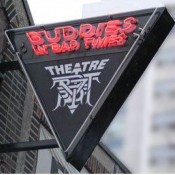The following is an exchange of emails between Karen Bernard and Devon Elke, both artists are performing in the final week of Rhubarb.
DE: Can you tell me about your encounter or relationship with Swimming Pool / Ozon that made you want to use it as a point of reference in this piece?
KB: I was in a three week residency at Wassard Elea in Ascea, Italy. I had taken movies with me to entertain myself at night. One of them was the Swimming Pool. I related to the main female character, an English mystery writer who goes to France to write—and how an erotic thriller enfolds. I have been creating a parallel abstracted and distilled personal drama. The video images I use come from my travels over the last two years. How about yourself?
DE: I was searching for a source for this project and my partner suggested Gertrude Stein and I uncovered Tender Buttons. As for this particular text, I’ve spent an over-abundance of time watching, studying, practicing what some might call ‘living room drama’. I hoped that Tender Buttons would keep me grounded in a pursuit of something different: a structural or instinctual logic rather than representational.
You mentioned a residency at Wassard Elea and your website categorizes Ouette as ‘in progress’ … can you tell me a little bit about the stages of building your work? Has anyone inspired or influenced your process of creation?
KB: My work grows from where I am at in my life—often related to family issues, the negotiation of being an artist, body image, sexuality and mortality. These are recurring themes. The work is always physically driven, but often in conjunction with conversation, visual elements, nostalgia and humor. I decided to play down the fourth wall, not be a funny character — but retain levity, and explore independence, solitude, sexuality and mortality. In a way I have left my family behind — as the kids are grown and my husband and I allow a freedom of independence.
The work is built intuitively: there is no game plan. It keeps building upon itself: often music inspires dance, and in this case, I have really enjoyed videoing and editing images and sound. Working with video is satisfying the visual artist side of me, although I have often seen myself as a moving sculpture. I have been inspired by Joseph Beuys, Gilbert and George, and Cindy Sherman. I would like to know more about what you meant by “living room drama” and “structural or instinctual logic rather than representational.”
DE: The “living room drama”—for me—is a tradition in Canadian theatre where the goal is verisimilitude; using affective memory to represent “reality”. Narrative provides the driving logic. The very essence of the style is to keep the choices (the construction of reality) hidden. And this theatre, therefore, denies its very political role in reinforcing limiting, constrictive ideologies.
And so how to create performance that allows the spectator to assign their own meaning? A theatrical experience that appeals to more than conscious intellect? Inspired by what Stein accomplished in Tender Buttons, I am searching for a process that relies less on the ego and instead utilizes formal experiments with tempo, pattern, level, repetition, etc. as the building blocks of creation.
You’ve said that you look for natural or clichéd movements that become abstracted by repetition. Did Swimming Pool provide any movement motifs that found way into your piece?
KB: Yes…”Sarah,” the English writer, was shut down physically , prim and proper, but steaming underneath. I have added gestures embodying this feeling—in particular from a dance sequence that happens in the movie.
BG

